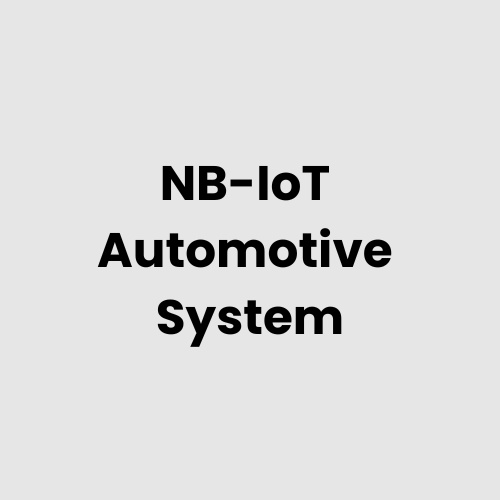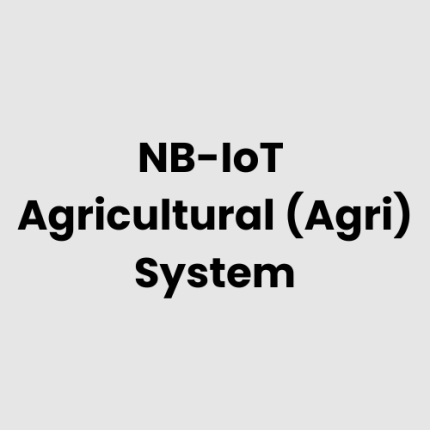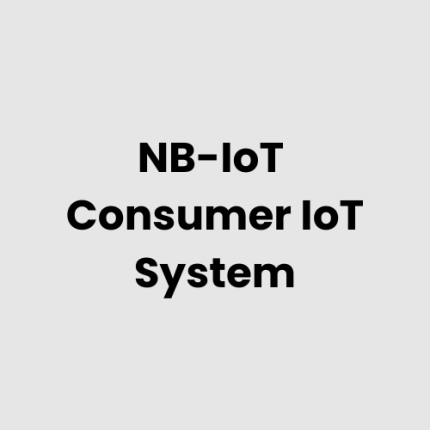Description
Technical Architecture
The NB-IoT Enabled Automotive System is built on a robust and scalable architecture that integrates NB-IoT connectivity to enable seamless communication between vehicles, infrastructure, and cloud platforms. The system architecture consists of several key layers:
- Vehicle Layer: This includes the onboard sensors, telematics units, and actuators that capture vehicle-specific data, such as engine performance, fuel efficiency, tire pressure, location, and more. These data points are transmitted via NB-IoT modules, ensuring continuous, low-power, and reliable communication.
- Connectivity Layer: NB-IoTmodules embedded in vehicles enable communication with the surrounding infrastructure, such as road sensors, charging stations, or nearby service centers. This ensures uninterrupted data flow for real-time updates, diagnostics, and fleet management.
- Data Processing and Management Layer: The collected data is processed in real-time either on local servers or sent to cloud-based platforms for advanced analytics, insights, and decision-making. This layer can leverage edge computing to reduce latency and provide faster responses.
- Control and Monitoring Layer: Centralized systems manage vehicle fleets, perform predictive maintenance, track vehicle conditions, and offer remote control functionalities, ensuring optimal vehicle performance.
This multi-layered architecture ensures a flexible, scalable, and highly reliable NB-IoT Enabled Automotive System for a variety of use cases, including fleet management, vehicle diagnostics, autonomous driving, and connected car services.
Hardware of the NB-IoT Enabled Automotive System
The NB-IoT Enabled Automotive System includes a range of hardware components designed to capture and transmit real-time vehicle data:
- Telematics Units: These are the primary devices installed in vehicles to collect data from onboard sensors and transmit it to the cloud or local servers. They include NB-IoT communication modules for secure, low-power data transfer.
- Sensors: Various sensors are used to monitor parameters such as speed, fuel efficiency, tire pressure, temperature, humidity, and GPS location. These sensors are critical for tracking vehicle health and ensuring safe operation.
- NB-IoT Communication Modules: Embedded in the telematics units, these modules ensure the vehicle can communicate with the NB-IoT network, whether on the road or at rest in a garage or parking lot.
- Edge Computing Devices: These devices process data locally for faster decision-making, reducing the need for constant cloud communication. This is particularly useful for applications like predictive maintenance and real-time alerts.
- Gateways: Gateways are used to facilitate communication between multiple vehicles and their cloud platforms or local systems, especially in fleet management applications, ensuring that multiple data points are efficiently processed and transmitted.
- Cloud/Local Servers: Cloud or on-premise servers are used to store, analyze, and manage vehicle data at scale, enabling fleet owners to monitor their vehicles remotely, track performance, and optimize routes and fuel consumption.
Physical Placement Considerations
When deploying the NB-IoT Enabled Automotive System, the physical placement of hardware components plays a vital role in ensuring optimal system performance:
- Telematics Units: The telematics unit is typically installed inside the vehicle, either under the dashboard or in a more accessible location like the glove compartment. It should be securely mounted to ensure stable connectivity and protection from environmental factors.
- Sensors: Sensors should be installed in locations where they can accurately measure the relevant parameters. For example, tire pressure sensors are typically located within the wheels, while temperature and humidity sensors might be placed in the engine compartment or the cabin.
- Communication Modules: NB-IoT communication modules should be placed in locations within the vehicle with good cellular coverage, typically near the telematics unit for efficient signal transmission.
- Edge Devices and Gateways: These devices should be strategically placed in locations where they can easily communicate with multiple vehicles or devices, such as in fleet management hubs, warehouses, or parking lots.
- Power Supply: Power supply considerations are essential, especially in remote or long-haul vehicle deployments. Solar charging solutions, backup battery systems, or the vehicle’s internal power system may be used to ensure continuous operation.
Hardware Architecture
The hardware architecture of the NB-IoT Enabled Automotive System is designed to be both modular and scalable. Key components include:
- Telematics Unit: The central hub of data collection, responsible for gathering information from various sensors, processing it, and transmitting it via NB-IoT
- Sensor Network: Includes various onboard sensors like GPS modules, speedometers, tire pressure sensors, fuel sensors, and more. These sensors provide real-time data crucial for monitoring vehicle health and performance.
- Communication Infrastructure: NB-IoT communication modules provide connectivity to the cloud or local servers, enabling seamless communication between vehicles, infrastructure, and central systems.
- Edge Computing Devices: Localized data processing units help reduce latency and enable faster decision-making for applications such as vehicle diagnostics or emergency response.
- Centralized Data Platform: Servers or cloud-based platforms aggregate, process, and analyze data from the vehicles, providing fleet managers with actionable insights, including predictive maintenance, fuel optimization, and driver behavior analysis.
Deployment Considerations
When deploying the NB-IoT Enabled Automotive System, several key considerations must be taken into account:
- Network Coverage: NB-IoT connectivity must be available in the areas where vehicles will operate. For remote locations, the system may require integration with local gateways to bridge communication gaps.
- Fleet Size and Scalability: The system should be scalable to handle growing fleets, enabling seamless expansion without significant infrastructure changes.
- Power Management: Ensure the power supply can support the system’s needs, especially in vehicles that may not always be in use. The use of solar panels, backup batteries, or integrating the system with the vehicle’s internal power is often required.
- Security: Data security is paramount in automotive systems, particularly for sensitive information related to vehicle diagnostics, driver behavior, and location. Robust encryption and secure communication protocols should be implemented.
- Maintenance and Support: Ongoing maintenance and monitoring are required to ensure the system continues to function optimally. GAO Tek’s expert support can assist with installation, troubleshooting, and system upgrades.
List of Relevant Industry Standards and Regulations
- ISO 26262 – Road vehicles – Functional safety
- ETSI TS 137 340 – NB-IoT technology standard
- ISO 15118 – Electric vehicle communication
- IEEE 802.11p – Wireless access in vehicular environments (WAVE)
- UNECE R79 – Regulation for vehicle safety
- GDPR (General Data Protection Regulation) – Data protection and privacy
- SAE J1939 – Vehicle CAN bus standard
- NHTSA (National Highway Traffic Safety Administration) regulations – Automotive safety
Local Server Version
For use cases where data sovereignty, privacy, and low-latency are priorities, the NB-IoT Enabled Automotive System can operate with a local server setup:
- On-Site Control: Data is processed and stored locally within the fleet management center, reducing the dependency on external cloud services.
- Faster Response Times: By processing data on-site, the system can deliver quicker insights, alerts, and real-time notifications for fleet managers.
- Security: With data kept on-site, the risk of external data breaches is reduced, providing enhanced data security for sensitive vehicle and driver information.
- Reduced Cloud Dependency: Local servers allow for better control over the system’s hardware and software, making it a cost-effective solution for large fleets.
Cloud Integration and Data Management
For businesses seeking remote monitoring and centralized management, cloud integration offers the following benefits:
- Scalable Data Storage: Cloud platforms provide virtually unlimited storage capacity, allowing for efficient handling of large amounts of vehicle data across multiple fleets.
- Advanced Analytics: Cloud systems enable sophisticated analytics, such as predictive maintenance, fleet optimization, and driver behavior analysis, helping companies reduce operational costs and improve efficiency.
- Remote Monitoring and Control: Fleet managers can access vehicle data in real-time from anywhere, improving decision-making and response times for fleet operations.
- Data Security and Compliance: Cloud providers ensure that the system meets relevant automotive industry regulations and standards, with strong encryption and secure data transmission protocols in place.
GAO Case Studies of NB-IoT Enabled Automotive System
USA Case Studies
- Detroit, Michigan
NB-IoT technology was integrated into Detroit’s automotive industry to monitor vehicle tire pressure in real time. This system provides valuable data to help prevent tire-related accidents, contributing to the city’s focus on automotive safety innovation. - San Francisco, California
In San Francisco, NB-IoT sensors were installed in public transport vehicles to track fuel efficiency and engine performance. The data collected enables optimized routing, reducing emissions and contributing to the city’s green energy goals. - Los Angeles, California
Los Angeles used NB-IoT for smart vehicle fleet management in its public transport system. The technology enabled real-time tracking of vehicle location and condition, leading to improved fleet maintenance and enhanced operational efficiency. - Chicago, Illinois
NB-IoT was deployed in Chicago to enhance the monitoring of vehicle diagnostics and traffic patterns. This technology helps in reducing maintenance costs and supports efforts to manage city traffic congestion effectively. - New York City, New York
In New York, NB-IoT sensors were incorporated into taxi fleets for advanced vehicle diagnostics. Real-time data on engine health helped reduce downtime and optimize fuel consumption across the city’s extensive fleet. - Miami, Florida
Miami deployed NB-IoT systems in its municipal fleet to track vehicle location, maintenance schedules, and driver behavior. This integration significantly improved fleet management and operational efficiency while contributing to environmental sustainability. - Austin, Texas
Austin leveraged NB-IoT for real-time monitoring of electric vehicles’ battery health. The technology helps ensure that the fleet remains operational, reducing maintenance costs and providing insights into potential charging infrastructure upgrades. - Seattle, Washington
Seattle used NB-IoT technology in its automotive systems to monitor vehicle air quality. The system tracks emissions, contributing to the city’s efforts to reduce carbon footprints and meet sustainability targets. - Phoenix, Arizona
NB-IoT sensors were installed in Phoenix’s vehicle fleet to monitor tire pressure and fuel consumption. By providing real-time data, the system enables more efficient route planning and enhances the fleet’s overall performance. - Washington, D.C.
In Washington, D.C., NB-IoT enabled the government to implement an intelligent parking system. The system tracks parking space availability, optimizing traffic flow and reducing congestion in busy districts. - Boston, Massachusetts
NB-IoT was implemented in Boston’s urban transit buses to monitor brake wear and battery life, ensuring the fleet’s reliability. This data helps improve overall safety standards for public transportation. - San Diego, California
San Diego used NB-IoT in its vehicle monitoring system to optimize traffic signal timing and reduce congestion. The data helps ensure smoother traffic flow while also minimizing vehicle emissions. - Salt Lake City, Utah
In Salt Lake City, NB-IoT technology was utilized to manage public buses by monitoring fuel consumption and engine performance. This technology helps optimize operational costs and supports sustainability goals. - Portland, Oregon
Portland implemented NB-IoT to track the location and performance of electric vehicle charging stations. The system ensures these stations operate efficiently and meet the growing demand for EV charging. - Houston, Texas
NB-IoT sensors were deployed in Houston’s logistics and transportation fleets to monitor vehicle performance, including engine temperature and fuel levels. This data supports the city’s initiative for more efficient urban mobility.
Canada Case Studies
- Toronto, Ontario
In Toronto, NB-IoT technology was applied in smart car systems to provide insights into battery health and driving patterns. This data is used to improve traffic management and reduce urban congestion. - Vancouver, British Columbia
Vancouver utilized NB-IoT sensors in autonomous vehicles to track real-time data related to vehicle health and traffic conditions. The technology helps optimize traffic flow and vehicle efficiency while promoting sustainable transportation solutions.
Navigation Menu for NB-IoT
Navigation Menu for IoT
- LORAWAN
- Wi-Fi HaLow
- Z-WAVE
- BLE & RFID
- NB-IOT
- CELLULAR IOT
- GPS IOT
- IOT SENSORS
- EDGE COMPUTING
- IOT SYSTEMS
Our products are in stock and can be shipped anywhere in the continental U.S. or Canada from our local warehouse. For any further information, please fill out this form or email us.
We are actively looking for partners who are like us located in the U.S. and Canada. For more information on partnering with GAO, please visit Partner with GAO Tek Inc. It lists various ways to partner with GAO, such as OEM Partnerships, Technology Integration, Distribution and Reselling Opportunities, Presenting at the Leading Event Tek Summit, Joint R&D Projects, Training and Consulting Services, Industry-Specific Collaborations, Research and Academic Partnerships.



